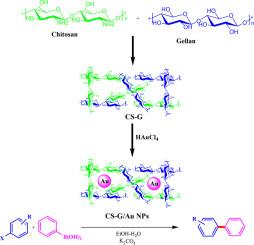壳聚糖-结冷胶聚合物上金纳米颗粒作为铃木偶联反应的新型催化剂的设计和支撑
IF 2.1
3区 化学
Q3 CHEMISTRY, INORGANIC & NUCLEAR
引用次数: 0
摘要
本研究介绍了一种设计和合成壳聚糖-结冷多糖(CS-G)水凝胶聚合物模板的新方法,以包封金纳米粒子,从而获得独特的生物纳米复合材料。CS-G水凝胶网络是通过氢键形成的,并进一步提供了一种天然模板,作为固定金纳米颗粒的封盖、还原和稳定剂(Au NPs@CS-G)。通过一系列先进的分析技术,如UV-vis, TEM, FE-SEM, EDX和ICP-OES,证实了Au NPs@CS-G的成功形成。TEM图像显示,金纳米颗粒呈球形,单分散,尺寸约为20-30 nm。在室温条件下,通过Suzuki-Miyaura反应对该材料的CC偶联催化性能进行了评价,结果表明该材料对联芳基化合物的催化效率很高。本文章由计算机程序翻译,如有差异,请以英文原文为准。

Design and supported of gold nanoparticles over the chitosan-gellan polymers as a novel catalyst for Suzuki coupling reactions
This study introduces a novel approach for designing and synthesizing a hydrogel polymer template derived from chitosan-gellan polysaccharides (CS-G) to encapsulate gold nanoparticles, resulting in a unique bio-nanocomposite. The CS-G hydrogel network was formed through hydrogen bonding and further providing a natural template that serves as a capping, reducing, and stabilizing agent for the immobilization of gold nanoparticles (Au NPs@CS-G). The successful formation of the Au NPs@CS-G was confirmed using a range of advanced analytical techniques such as, UV–vis, TEM, FE-SEM, EDX, and ICP-OES. TEM images revealed that the gold nanoparticles were spherical in shape, monodispersed, and had an approximate size of 20–30 nm. Catalytic performance of the material was evaluated in C![]() C coupling via Suzuki-Miyaura reaction in aqueous medium at room temperature, which revealed remarkable productivity of biaryl compounds.
C coupling via Suzuki-Miyaura reaction in aqueous medium at room temperature, which revealed remarkable productivity of biaryl compounds.
求助全文
通过发布文献求助,成功后即可免费获取论文全文。
去求助
来源期刊

Journal of Organometallic Chemistry
化学-无机化学与核化学
CiteScore
4.40
自引率
8.70%
发文量
221
审稿时长
36 days
期刊介绍:
The Journal of Organometallic Chemistry targets original papers dealing with theoretical aspects, structural chemistry, synthesis, physical and chemical properties (including reaction mechanisms), and practical applications of organometallic compounds.
Organometallic compounds are defined as compounds that contain metal - carbon bonds. The term metal includes all alkali and alkaline earth metals, all transition metals and the lanthanides and actinides in the Periodic Table. Metalloids including the elements in Group 13 and the heavier members of the Groups 14 - 16 are also included. The term chemistry includes syntheses, characterizations and reaction chemistry of all such compounds. Research reports based on use of organometallic complexes in bioorganometallic chemistry, medicine, material sciences, homogeneous catalysis and energy conversion are also welcome.
The scope of the journal has been enlarged to encompass important research on organometallic complexes in bioorganometallic chemistry and material sciences, and of heavier main group elements in organometallic chemistry. The journal also publishes review articles, short communications and notes.
 求助内容:
求助内容: 应助结果提醒方式:
应助结果提醒方式:


